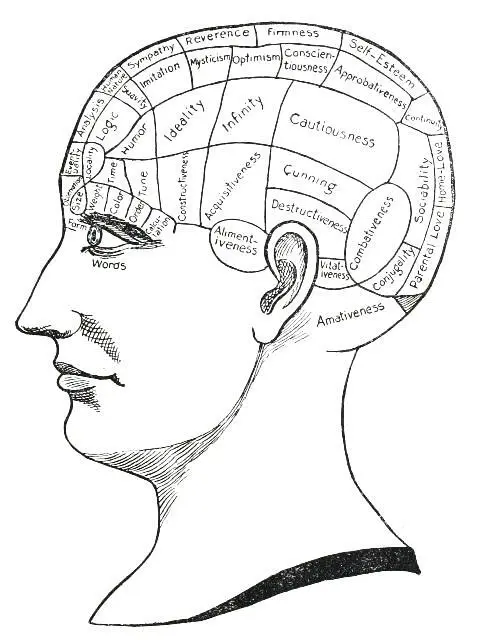CHAPTER V
THE MENTAL QUALITIES
Table of Content
We now approach the subject of the several particular mental qualities, and the groups thereof, both in the phase of their inner states and that of their outer form. In the consideration of both of these phases we must avail ourselves of the investigations and researches of the old phrenologists who cleared a path for all who follow. Although many of the phrenological theories are rejected by modern psychologists and biologists, nevertheless their work established a firm foundation for the science of the study of the brain and its functions. And to Gall and his followers we are indebted for the discovery and teaching that the activity and development of the several mental qualities or faculties manifest in outer form in the shape of the skull.

Fig. 1
THE MENTAL QUALITIES
The general principles of phrenology may be briefly stated as follows:
I. The Brain is the organ of the mind.
II. The mind is not a single entity or power, but has several faculties, stronger or weaker, which determine the character of the individual.
III. That each faculty or propensity has a special organ in the brain.
IV. The size of the brain (the quality being equal) is the true measure of power.
V. There are several groups of faculties, and each group is represented by organs located in the same region of the brain.
VI. The relative size of each organ results from the activity of its appropriate faculty.
VII. The size of the organ is indicated by the appearance and size of the skull immediately over the region of the organ.
VIII. The Quality and Temperament of the organization determine the degree of vigor, activity, and endurance of the mental powers.
Modern psychology and biology claim to have disproven many of the phrenological contentions, while other lines of investigation have given us other theories to account for the phenomena first noted by the phrenologists. Some investigators of brain development and action hold that while certain mental states manifest in outer form on portions of the skull, the phenomenon is due to the action of the cranial muscles rather than to the fact of the localization of special faculties—that each mental state is associated with certain actions on the part of certain cranial muscles which in turn exert a modifying effect upon the shape and size of the skull.
As Erbes states it "the effect the scheme of cranial muscles have had and still have upon the conformation of the skull, and, consequently, had in determining the location of those areas and in giving brain and mind a character approximately identical from end to end of the scale of living things possessing the cerebro-spinal nervous system. In so far as the neural matter is dependent upon the cranial muscles—aside from the sensory stimuli—so far, likewise are the psychic manifestations, through tongue or limb, modified by variations in those muscles that, after their creative task is done, assume a vasomotor control over their respective areas." The same writer also says: "The cerebral mass owes its location and subsequent expansion, moreover, in a measure that mind owes its character, primarily to the action of the muscles attached to and lying upon its peripheral covering, the skull; these same muscles thereafter, through exercising a cerebral vasomotor control, act in the nature of keys for calling the evolved dependent brain areas into play, singly and en masse."
Others have held that the development of certain areas of the surface of the skull is due to peculiar neural or nervous, activities having their seat in certain parts of the brain adjacent to their appropriate area of the skull, but these theories fail to explain the nature of the relation between the mind, brain and the "nerve centres" aforesaid.
These several authorities, and others, however, agree upon the fact that certain areas of the brain are associated in some way with certain mental states; and that these brain areas register their relative activity upon the areas of the skull adjacent thereto; and that the activity and power of each brain area, or faculty, is denoted by the size of the associated skull-area. Thus, the outward facts claimed by phrenology are admitted, while their theories of cause are disputed.
In this book we shall rest content with these "outward facts" of phrenology, and shall not concern ourselves with the various theories which seek to explain them, preferring to leave that task for others. In considering the subject of the Outer Form associated with the Inner State of Human Nature, we shall merely claim that mental states manifest in outer form in the shape and size of the head; and that certain areas of the skull are thus associated with certain mental states, the size and shape of the former denoting the degree of activity of the latter .
The general scheme of classification of the various mental "faculties" of the phrenologists, and the names given thereto by the old phrenologists, have in the main been adhered to in this book. In a number of cases, however, we have seen fit to re-arrange the groups in accordance with the later ideas of the New Psychology, and have given to some of the "faculties" names considered more appropriate to the later classification, and understanding of the mental state. Moreover, in order to avoid the phrenological theories attaching thereto, we have decided not to use the terms, "faculties," "propensities," and "sentiments," in referring to the several mental states; and shall therefore use the term " Qualities " in the place thereof. The term "quality," while denoting "the condition of being such or such; nature relatively considered," does not carry with it the theory attached to the phrenological term "faculty." But the locality of the several qualities of "faculties" has not been disturbed or changed—the place where each quality manifests in outer form , as assigned in this book, agrees with that assigned by the old phrenologists, time having served to establish the truth of the same, rather than to disprove it.
The following is the classification and terminology adopted by us in this book in the consideration of the Mental Qualities. (See Fig. 1.)
I. THE EGOISTIC QUALITIES: Self-Esteem; and Approbativeness.
II. THE MOTIVE QUALITIES: Combativeness; Destructiveness; Cunning; Cautiousness; Acquisitiveness; and Constructiveness.
III. THE VITATIVE QUALITIES: Vitativeness; Alimentativeness; and Bibativeness.
IV. THE EMOTIVE QUALITIES: Amativeness; Conjugality; Parental Love; Sociability and Home-Love.
V. THE APPLICATIVE QUALITIES: Firmness; and Continuity.
VI. THE MODIFICATIVE QUALITIES: Ideality; Infinity; and Humor.
VII. THE RELATIVE QUALITIES: Human Nature; Suavity; Sympathy; and Imitation.
VIII. THE PERCEPTIVE QUALITIES: Observation; Form; Size; Weight; Color; Order; Calculation; Tune; Time; Locality; Eventuality; and Words.
IX. THE REFLECTIVE QUALITIES: Analysis; and Logic.
X. THE RELIGIO-MORAL QUALITIES: Reverence; Mysticism; Optimism; and Conscientiousness.
In the following several chapters we shall consider each group, in turn, together with the particular Qualities of each group. It must be remembered that the power of each Quality is modified by the influence of the other Qualities. Therefore in judging the character of an individual, each and every Quality must be taken into consideration.
CHAPTER VI
THE EGOISTIC QUALITIES
Table of Content
The first group of Qualities is that known as the Egoistic Qualities, which is composed of two particular Qualities, known, respectively, as Self-Esteem ; and Approbativeness . This group manifests outer form immediately at the "crown" of the head, and on the sides directly beneath or "side of" the crown. (See Fig. 2.) It is the seat of the consciousness of Individuality and Personality, and the tendencies arising directly therefrom.
Читать дальше













